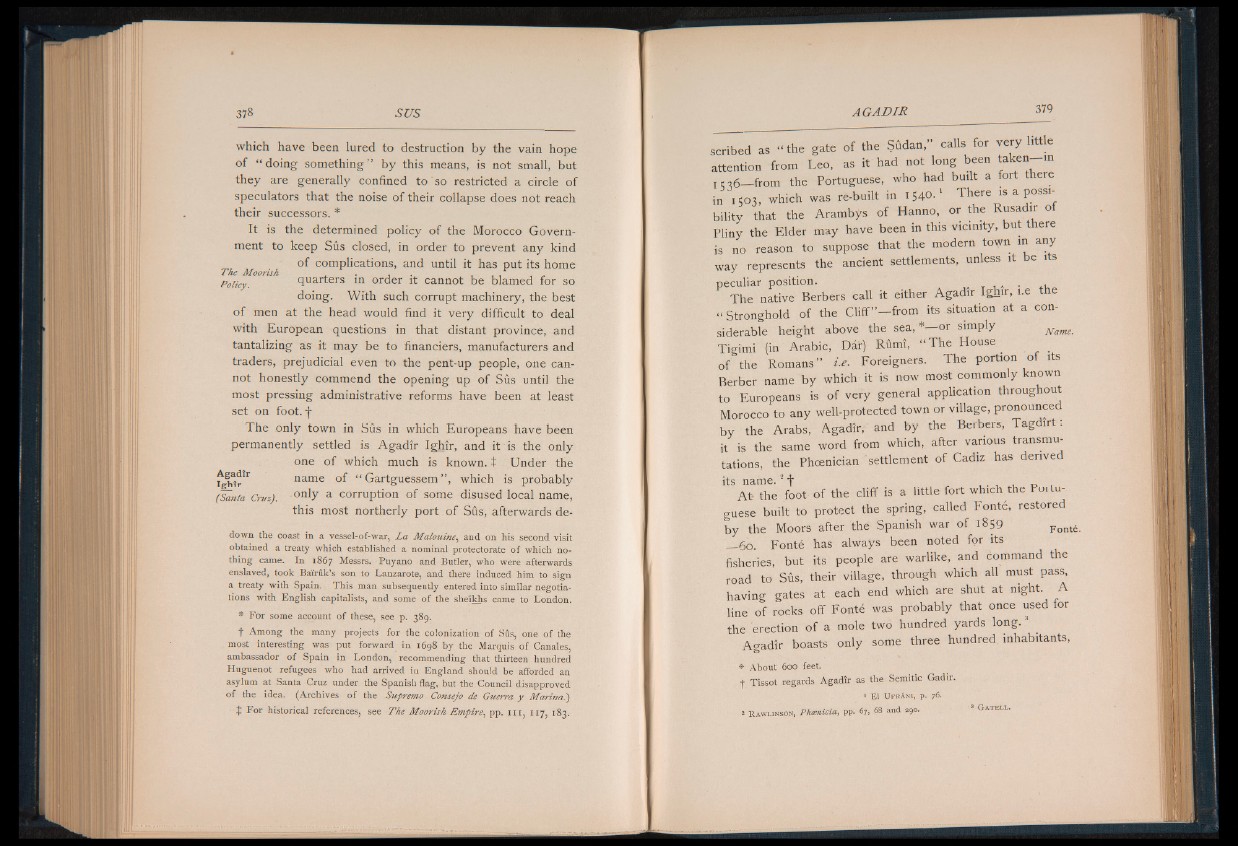
which have been lured to destruction by the vain hope
of “ doing something” by this means, is not small, but
they are generally confined to so restricted a circle of
speculators that the noise of their collapse does not reach
their successors. *
It is the determined policy of the Morocco Government
to keep Sus closed, in order to prevent any kind
of complications, and until it has put its home
The Moorish > . . t t , _
Policy. quarters in order it cannot be blamed for so
doing. With such corrupt machinery, the best
of men at the head would find it very difficult to deal
with European questions in that distant province, and
tantalizing as it may be to financiers, manufacturers and
traders, prejudicial even to the pent-up people, one cannot
honestly commend the opening up of Sus until the
most pressing administrative reforms have been at least
set on foot, f
The only town in Sus in which Europeans have been
permanently settled is Agadir Ighir, and it is the only
one of which much is known, t Under the
fghir11 name of “ Gartguessem ” , which is probably
(Santa Cruz). only a corruption of some disused local name,
this most northerly port of Sus, afterwards dedown
the coast in a vessel-of-war, La Malouine, and on his second visit
obtained a treaty which established a nominal protectorate of which no-
thing came. In 1867 Messrs. Puyano and Butler, who were afterwards
enslaved, took Bairuk’s son to Lanzarote, and there induced him to sign
a treaty with Spain. This man subsequently entered into similar negotiations
with English capitalists, and some of the sheikhs came to London.
* For some account of these, see p. 389.
t Among the many projects for the colonization of Stls, one of the
most interesting was put forward in 1698 by the Marquis of Canales,
ambassador of Spain in London, recommending that thirteen hundred
Huguenot refugees who had arrived in England should be afforded an
asylum at Santa Cruz under the Spanish flag, but the Council disapproved
of the idea. (Archives of the Supremo Consejo de Guerra y Marina.)
% For historical references, see The Moorish Empire, pp. i n , 117, 183.
scribed as “ the gate of the Sûdan,” calls for very little
attention from Leo, as it had not long been f « * - *
I c 36— from the Portuguese, who had built a fort there
in ,503, which was re-built in i S4° . 1 There is a possibility
that the Arambys of Hanno, or the Rusadir of
Pliny the Elder may have been in this vicinity, but there
is no reason to suppose that the modern town in any
way represents the ancient settlements, unless it be its
peculiar position. a .
The native Berbers call it either Agadir Ighir, i.e
“ Stronghold of the Cliff”— from its situation at a considerable
height above the sea, *— or simply Name.
Tigimi (in Arabic, Dâr) Rûmî, “ The House
of the Romans” i.e. Foreigners. The portion of its
Berber name by which it is now most commonly known
to Europeans is of very general application throughout
Morocco to any well-protected town or village, pronounced
by the Arabs, Agadir, and by the Berbers, Tagdirt :
it is the same word from which, after various transmutations,
the Phoenician settlement of Cadiz has derived
its name.2 f * -
Ah the foot of the cliff is a little fort which the Portuguese
built to protect the spring, called Fonté, restored
by the Moors after the Spanish war of 1859 Font(
,_ 6o. Fonté has always been noted for its
fisheries, but its people are warlike, and command the
road to Sûs, their village, through which all must pass,
having gates at each end which are shiit at night. A
line of rocks off Fonté was probably that once used for
the erection of a mole two hundred yards long. 5
Agadir boasts only some three hundred inhabitants,
* About 600 feet.
f Tissot regards Agadir as the Semitic Gadir.
1 El Ufrani, p. 76.
2 Rawlinson, Phoenicia, pp* 67, 68 and 290. G a t e l l .